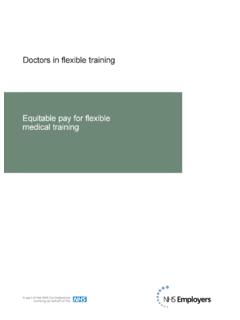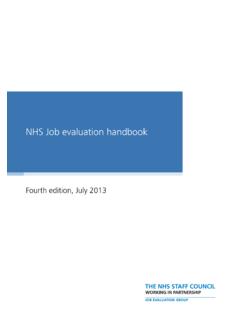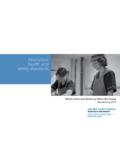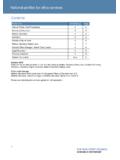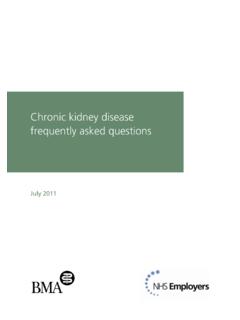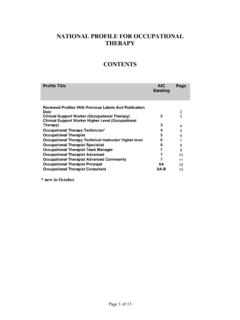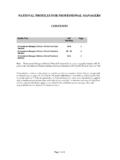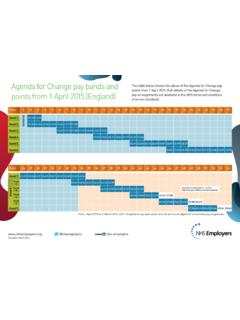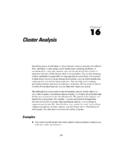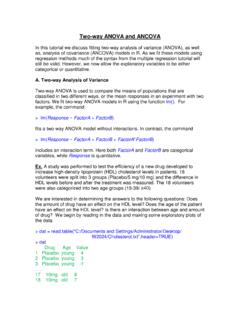Transcription of Annex D: Carr-Hill resource allocation formula - …
1 Annex D: Carr-Hill resource allocation formula Introduction 1. This Annex presents the core findings from the analysis used to derive the Carr-Hill resource allocation formula for the new GMS contract. This will be used to allocate the global sum and related payments on the basis of the practice population, weighted for factors that influence relative needs and costs. The proposed formula includes the following components: an adjustment for the age and sex structure of the population, including patients in nursing and residential homes an adjustment for the additional needs of the population, relating to morbidity and mortality an adjustment for list turnover adjustments for the unavoidable costs of delivering services to the population, including a staff Market Forces Factor and rurality. 2. The formula differs from those previously developed for resource allocation purposes in two key respects. First, the majority of the formula is to be applied to the four countries within the United Kingdom.
2 Secondly, the formula will be applied to practice populations, rather than Primary Care Organisation populations. 3. The approach to the formula follows that established elsewhere in the field of resource allocation : namely, expressing relative need in cost terms. This involves establishing an age-sex cost curve, estimating the additional resource implications of additional needs, and then adjusting for other factors that affect the cost of delivering services. Given the difficulties of collecting data in this area, a large number of different exercises have been carried out. This Annex summarises the approaches and the main results. Age-Sex Workload Curve 4. The basis of any allocation formula for a set of services is the population served. For General Medical Services in the UK this is defined by those registered on the lists of each general practitioner. Whilst those lists are well-defined (although there are well-known problems over list inflation see paragraph 31 below) there is no routine dataset that provides the basis for showing the entire workload generated by different age-sex groups on the practice list.
3 5. Consultations can take place in the surgery, the patient's own home or in a nursing or residential care home. There is no single data source adequately covering general practice consultations in all of these environments. Whilst there are routine data available on consultations in the surgery, there are only limited data on home visits and no systematic data on nursing and residential home consultations. Consequently they have to be estimated separately, with separate databases. Consultations in the Surgery: Analysis of General Practice Research Database (GPRD). 6. The analyses of surgery consultations have been based on the General Practice Research Database (GPRD). It includes data from 240 practices, including eight from Northern Ireland, ten from Wales and twelve from Scotland. The GPRD has individual level consultation frequencies and information on duration has been recorded for all members of the primary care health team in most of the practices since 1999. 7. The whole dataset covers a period from 1996 to August 2002 and contains details of 99.
4 Million consultations. However, prior to 1999 the vast majority of the computer systems in these 240 practices did not record when patient files were opened and closed. Of the whole dataset, 69% (68 million) of consultations were time-stamped. 8. It is important to emphasise that the GPRD material refers to "consultations", but these are simply instances of a patient's computer file being accessed. So a receptionist checking an appointment or a computer manager doing data checks will both count as consultations'. They are more properly referred to as file openings'. 9. It can be argued that the relative GP workload associated with different patient groups may be approximated by the times for which the files were open and that these data may also be used to estimate consultation rates. The obvious objections are that the opening of a patient's computer file may not denote a consultation and that the length of time for which the file is opened may not reflect the workload associated with the event being recorded.
5 An example of the latter would be the retrospective entering of details of a home visit. The retrospective entering of home visit details is unlikely to reflect the full workload of home visits, which are often longer than surgery visits and also have an associated travel time. For this reason, home visits have been treated separately. The age-sex workload adjustment is presented in Table 1 below. Table 1: Mean total time for which a patient file was opened in minutes per year: all staff, weighted by staff input cost. Males Females Average time Ratio to Average Ratio to male 5- per person male 5-14 time per 14. person 0-4 5-14 1 15-44 31 45-64 65-74 75-84 85+ 10. The counter-intuitive reduction in average time (and hence relative workload) for the most elderly patients could be explained by a higher proportion of very short file openings for those groups to record other information about the patient. Furthermore, these may refer to home or care home visits, the details of which are recorded post hoc and do not reflect the actual workload generated by home visits.
6 Home Visits 11. As discussed above, the GPRD does not adequately record home visits. Although the file may be opened in relation to home visits, this is likely to be for a relatively short period as the information is added after the home visit has taken place. This will therefore not reflect the full workload impact of the home visit. Length of the Home Visit 12. On the whole, a home visit tends to generate a higher workload than a surgery consultation, as the consultation itself is often longer and a home visit also has an associated travel time. According to the 1992-93 GP workload survey the average length of a home visit, including travel time, is 1. General Medical Practitioners' Workload Survey 1992-93. London: Department of Health, November 1994. Paragraph and Table D5. Variation by Age and Sex 13. The most extensive data available on home visits are those from the Morbidity Statistics for General Practice 4 (1991/92). A clear J' shaped relationship between age and home visiting rates is apparent for both males and females.
7 This is set out in Table 2 below. Table 2: Home visit rates per 1000 patient years 0-4 5-15 16-24 25-44 45-64 65-74 75-84 85+. Male 498 126 56 63 136 506 1331 2792. Female 454 128 150 163 200 608 1628 3081. 14. Applying the home visit length to these weights, and combining with the consultations in surgery produces an age-sex workload index, which is set out in Table 3. The formula uses different age-sex workload indices in Scotland and these are shown in Table 4. Table 3: Age-sex Workload Index (males aged 5-14 = 1): UK less Scotland 0-4 5-14 15-44 45-64 65-74 75-84 85+. Male 1 Female Table 4: Age-sex Workload Index (males aged 5-14 = 1): Scotland 0-4 5-14 15-24 25-44 45-64 65-74 75-84 85+. Male 1 Female Nursing and Residential Homes 15. Two separate surveys were carried out to analyse the relative workload generated by patients in nursing and residential homes. One was directed to nursing and residential homes, to generate information on the frequency of consultations, and the other to GPs, looking at time spent in nursing and residential home consultations.
8 Overall, patients in nursing and residential homes generate more workload than patients with otherwise similar characteristics who are not in nursing and residential homes. This is mainly due to the fact that all nursing and residential home consultations involve travelling time. The workload factor applied to patients in nursing and residential homes is List Turnover 16. Areas with high list turnover often have higher workload, as the patients in their first year of registration in a practice tend to have more consultations than other patients with otherwise similar characteristics. 17. The impact of list turnover was analysed using the GPRD, which contains data on patient registration date. The results of this analysis indicate that the average time in consultation' is some 40 to 50 per cent higher for patients in their first year of registration in the practice compared with other patients. The rate varies across age and sex bands, with young males having the strongest additional effect.
9 Rather than create an entirely separate age-sex cost curve for new registrations, the average uplift of a factor of will be applied to all new registrations. Additional needs 18. As well as the impact on practice workload generated by differing age and sex groups, the impact of indicators of mortality and morbidity on consultation frequency has been modelled. 19. This has been modelled using the Health Survey for England data between 1998 and 2000. The survey asks participants whether they have had a GP consultation in the past two weeks, and if yes the number of such consultations. The survey also includes information on age, sex, geographic location and a range of socio-economic indicators. These were combined with a range of other small area level explanatory variables, including census variables, mortality rates, and supply variables. The analysis was conducted at ward level, and wards were excluded where there were less than five observations in the ward. This reduces the sample size to 2,404 wards.
10 20. Of the variables tested, Standardised Limited Long-Standing Illness (SLLI) and the Standardised Mortality Ratio for those aged under 65 (SMR<65) were found to be significant and the best at explaining variations in workload over and above age and sex. They are related to workload by the following formula : Practice list adjusted for list inflation * (( + ( * SLLI) + ( *. SIR<65)) scaled back to the UK population (see paragraph 32). 21. As mentioned in paragraph , special provision is being made for Scotland. The evidence shows that although the Standardised Mortality Ratio helps to explain variations in additional need in Scotland, other factors perform better in combination with it than Standardised Limited Long-Standing Illness. Thus in Scotland, the explanatory variables used in addition to Standardised Mortality Ratio for those aged under 65 (SMR<65) are: unemployment rate elderly people on income support (aged 65 or more). households with two or more indicators of deprivation.)
